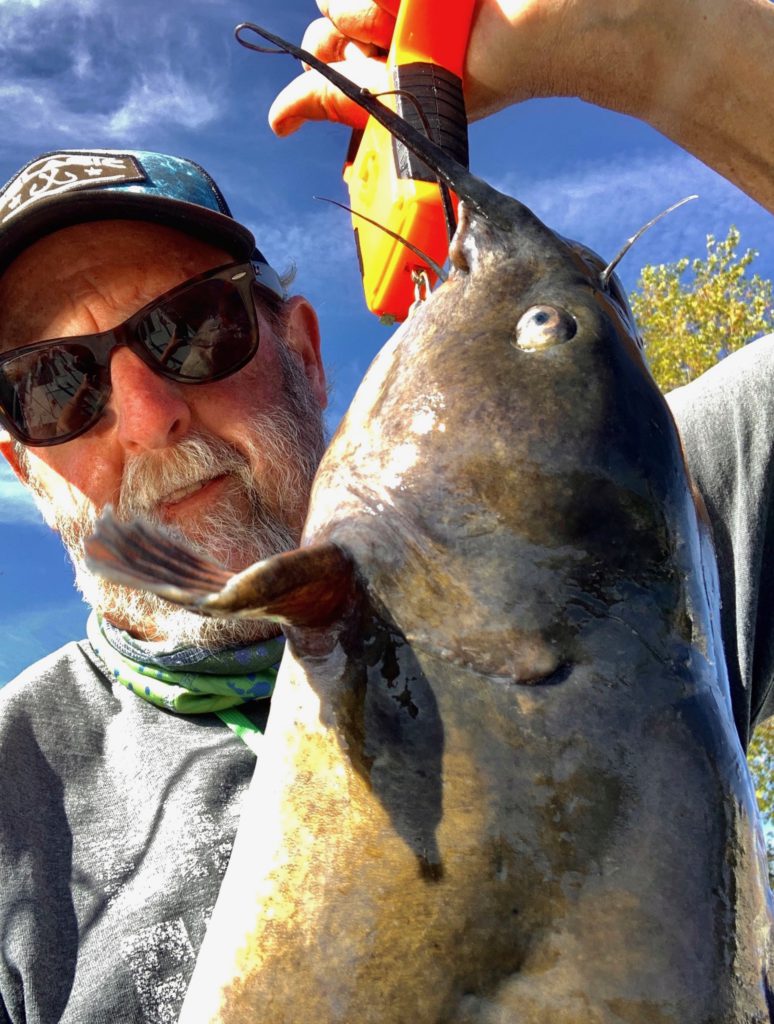Well, it’s officially winter. Fewer anglers on the water and fewer bass being caught. With holiday music in the background as I start to write this article, I hear ol’ blue eyes, Frank Sinatra, crooning a tune familiar to many, “Let It Snow! Let It Snow! Let It Snow!” Sorry Frank, but I have my own ending to the first verse…
“Oh the weather outside is frightful / But the fire is so delightful / And since we’ve no place to go… Let’s go bass fishing!
Ok, maybe not what Frank had in mind, but hey, I’m a fisherman and it doesn’t take much to make me want to wet a line. While family — and sometimes football — may take precedence and that warm fireplace is inviting, there’s still a gnawing tug in the back of my head that says I need to get my bass fishing fix.
Well the good news is, if you choose to go chase your habit at this time of year, you really don’t have to be out there at the crack of dawn. With temps dropping to the 40s and lower at night, the bass are probably not going to be waking up early either. Sleep in. Have breakfast with the family. If you don’t get on the water until late morning or early afternoon, you probably haven’t missed anything. Right, Frank?
Even in warmer weather, I’ve become a lazy bass fisher in the past few years, focusing on the late bite and that magical hour before sunset. At this time of year, the green bass seem to get more active once the chill is off the water, so that’s just fine with me.
As most bassers know, the key to catching winter bass is finding the forage — could be shad, silverside minnows or other finbait. Find the bait, find the fish. And while most schooling bass are on deeper water structure, there are always some fish tight to shoreline, especially around rocky areas that retain heat. The problem is getting them to bite.
I’m the first to admit that finding bass willing to bite now is very challenging. There will be days when that stinky critter with the black and white tail seems to be lurking in your subconscious. No one wants to get skunked, but it happens. So what can you do to improve your chances of avoiding Mr. Stinky? Here are a few thoughts…
Downsize your tackle
There are times when the size of your lures and weight of your line doesn’t impact your ability to catch a bass. There are also times when it very much does. Winter is one of those times. Yes, you can always catch bass on big lures, particularly when throwing trout-imitating swimbaits once the hatchery truck pulls up at your favorite lake and rings the dinner bell. But those catches are few and far between for the average angler not focused on trophy bass and just hoping for some action.
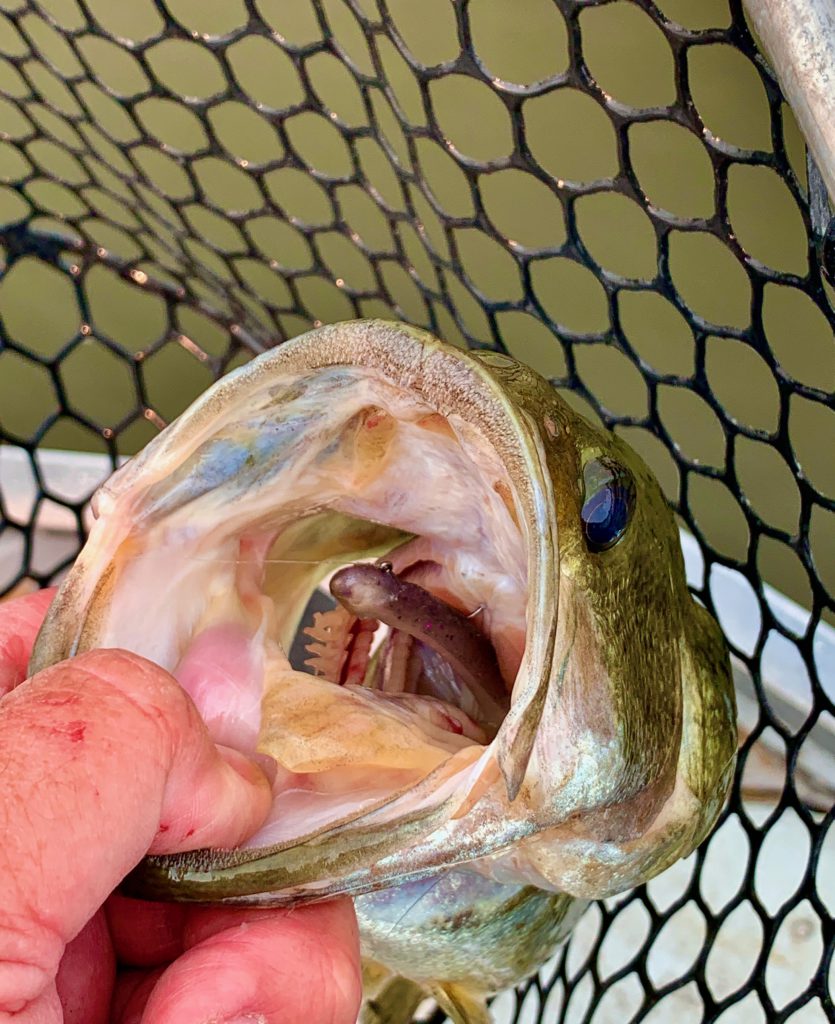
By and large, you’re better off downsizing your line weight and lure size. Light line, smaller lures and small hooks rule at this time of year. I’m doing more finesse fishing now and using spinning tackle with 15-pound braided line and fluorocarbon leaders of 6- to 8-pound test fished on medium to light 6 1/2- to 7 1/2- foot, fast-tapered rods. Occasion- ally I’ll even drop down to 4-pound fluoro leaders for bass. Finesse and stealth are the name of the game.
Finesse fishing also means fishing slower with smaller baits. Drop-shots with 4-inch Roboworms or Keitech swimbaits on number 2 octopus-style thin wire hooks are reliable choices, as are 3- to 4-inch swimbaits on 1/16-ounce dartheads, and small Ned or Neko rigs bounced along the bottom. Go with as little weight as possible. The lighter the sinker or jig head, the slower the descent. And that slow fall results in more fluttering action imparted to the lure, which makes it more likely to get bit on the sink or just before it hits bot- tom. Wacky-rigged flick-shake worms, small baitfish-imitating spoons or ice jigs work in a similar fashion.
Match the hatch
At this time of year, too many anglers are still power fishing, rapidly busting the shoreline and relying on their “confidence baits” when they should be fo- cusing on matching the hatch. If you say that you always throw a ____________ (insert your favorite lure here) because that’s what you catch most of your bass on, it’s probably because that’s what you fish most often. But when the bass aren’t responding to it, it may be because it’s too big, too noisy, moving too fast or just isn’t matching what they’re feeding on closely enough.
Time to put down your go-to bait and focus more on what the bass want instead of what your ego wants to throw at them. I too have been guilty of sticking with one of my favorite search baits — the Chatterbait — when I should be focused on matching the hatch. On the lake I fish most often, that would be silverside minnows at this time of year. There are times when they’re schooled up high in the water column and the bass slash through them, but most of the time they’re down and not so visible until near sunset when you see them dimpling the surface of the water.
Rely on your machinery to find the schooling bait and pick a lure that gets as close to the size, color and shape of the forage as possible. I’ve had great success at this time of year with small Hookup Baits in the 1/16- to 1/8-ounce size. It’s a tube bait that isn’t used too much for freshwater bass. Of course, tube baits have been around for decades, but there’s something to be said for the unique way these particular baits glide as they fall that seems to get the bass’ attention.

Sometimes showing the bass something they aren’t used to seeing is the difference-maker. I first started using Hookup Baits in saltwater for calico bass, casting them up against kelp beds and over reefs when the water is relatively warm. They get bit on the fall 90 percent of the time and are a lot of fun to fish. They’re also effective in colder water for winter sand bass, calicos, rockfish and other fish that stick close to the bottom.
When the largemouth are active, they’ll slurp up the Hookups on the fall, so fishing these baits requires watching your line for any movement. If you feel or see a slight tick or if it stops dropping, swing. Not a cross-their-lips kind of swing, but a short snap with your wrist or better yet, a gentle sweeping lift of your rod. Go with what feels right for you. When they become more lethargic, slowly jigging the little tubes off the bottom pays off. Colors that mimic the bait work best, like shad white, mint and green sardine.
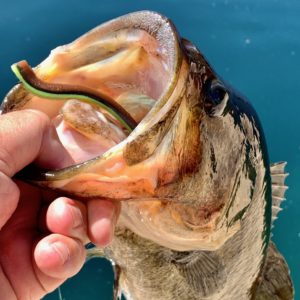 Presentation tips
Presentation tips
As temperatures drop during winter and the bass’ metabolism slows down, they feed less often and are less likely to chase a bait. They’re content to sit tight to the structure they’re on and wait for a meal to swim by within striking distance. Accurate vertical presentations are key. Whether you’re using Hookup Baits, drop-shotting, split-shotting, Neko or Ned rigging, you pretty much have to drop your bait right on their head to get them to bite.
Think of it like you would if you don’t want to cook and want to order restaurant food for dinner. You can put on your jacket, go out in the cold, get in your car and drive a distance to pick it up yourself, or have it delivered to your door. The bass don’t want to travel any more than you do. If someone could invent an UberEats for Bass app, they’d stay busy all winter.
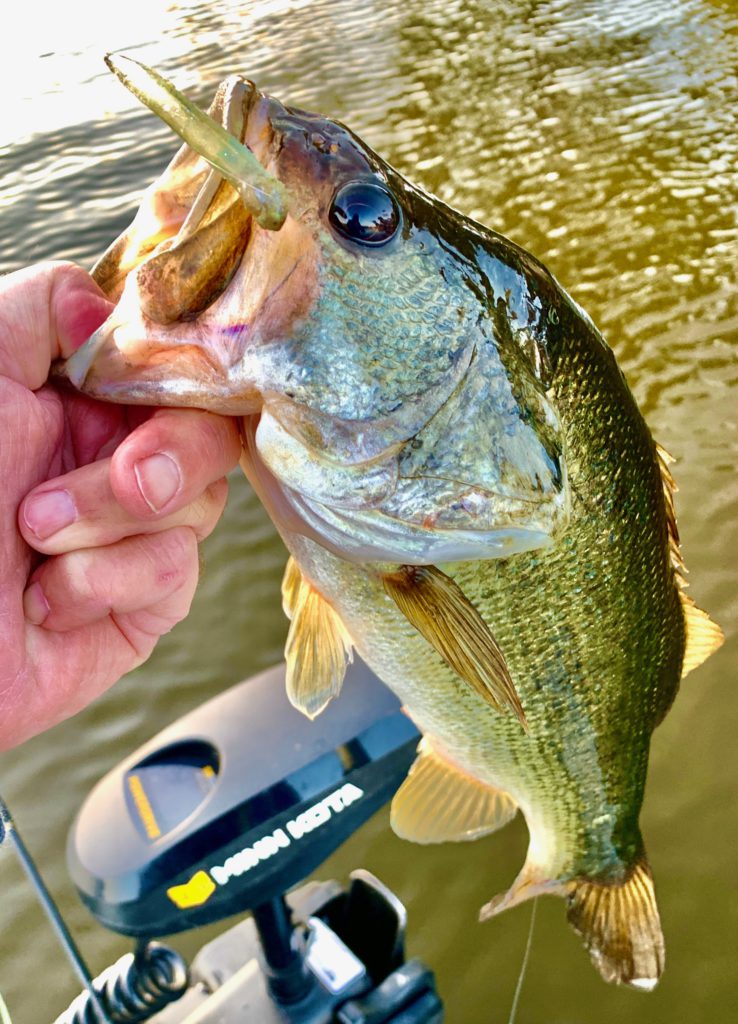
When searching for a productive zone to fish for winter bass, you’re most often looking for hard bottoms with rocks, timber or brush on it. If you catch a couple bass off a spot and it peters out, look for similar looking water at that same depth to see if you can establish a pattern.
If you’re fishing say, 25 to 35 feet deep on a sloping point and find fish on your meter right where a tree line or brush pile is sitting, chances are if you drop straight down on it, you may tend to hang up a rig with an ex- posed hook. To avoid getting stuck, you can try and drop or cast to the edges and hope to get the bass to move a few feet to swoop up your lure, or go with a more weedless presentation. Try using something like a Ned mushroom head jig with a light wire hook and Texas rig your worm so that the barb is covered. That way you’ll hang more bass and less brush.
Bass tricks
A common presentation mistake that many anglers tend to make is overworking their bait. You don’t need to constantly jig or jiggle your drop-shot, Neko or Ned-rigged baits. The current will do that for you. How many times have you had a wind knot or tangle that you’re trying to undo while your bait is just sitting on the bottom, and when you finally get the tangle out and reel up your slack line, you’re surprised to feel weight on the line and you hook a nice bass? Let the bait do the work for you.
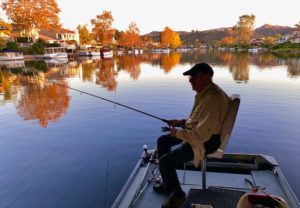
Remember, too, that you want your bait presented in a way that looks as natural as possible. Light line, fluoro leaders and small hooks make a difference, but there are other little tricks that also help. If you’re using Zoom finesse worms or Senkos, try stretching the worm out before putting it on your hook. You’ll find the stretched out worms to be softer and more natural looking, and they can generate more bites.
Another tip that might help comes into play when selecting jigheads for swimbaits. If you’re throwing a small swimbait, look for a jighead that has a sloping underside with the line tie on the nose of the jig instead of the top of it. Most line ties are positioned at a 90-degree angle to the top of the jighead and are more likely to pick up brush and debris. The front tie position reduces that problem. The other advantage of this forward line tie is that the jig tends to roll slightly from side to side when retrieving it, giving your plastic swimbait a “dying bait” look that makes a bass think it’s an easy meal.
At this time of year, you need every advantage you can find to get those finicky bass to bite.
Winter is definitely not the easiest time of year to catch fish, especially when it gets really cold. More than likely you’ve heard your spouse or friends say, “You must be out of your mind to go fishing now.” But even if the weather outside is frightful, catching a few chunky bass can be most delightful. So, zip up your jacket, bring along a Thermos of hot coffee, and go have some fun.
